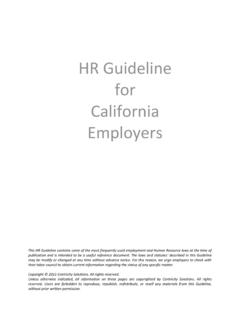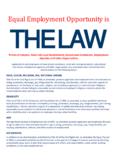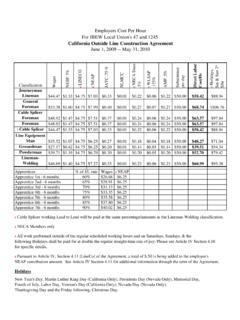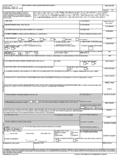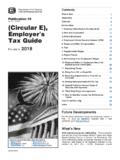Transcription of Working with sewage
1 Health and Safety ExecutiveWorking with sewageThe health hazards: A guide for employers 1 of 3 pagesIntroductionSeveral work activities bring workers into contact with sewage and sewage year, some workers will suffer from at least one episode of work-related majority of illnesses are relatively mild cases of gastroenteritis, but potentially fatal diseases, such as leptospirosis (Weil s disease) and hepatitis, are also reported to , there could well be significant under-reporting of cases because there is often failure to recognise the link between illness and is at risk?If you work in one of the following areas, your health, or that of your employees, may be at risk:local authority employees involved in sewer inspection and maintenance work; construction workers who repair or replace live sewers; water company employees who work with sewage treatment plant; agricultural and forestry workers who may be exposed to sewage sludge; sludge tanker drivers/operators and associated maintenance staff; plumbers.
2 Or employees who clean and maintain the underside of railway carriages and empty aircraft sewage compartments and other types of portable this leaflet is aboutThis leaflet describes some of the risks and the ways in which they can be either eliminated or reduced. It follows the principles of the Control of Substances Hazardous to Health Regulations 2002. This leaflet does not set out or interpret the law it has been produced simply to help is sewage ?The term may be used to mean raw sewage , sewage sludge, or septic tank sewage is mainly water containing excrement, industrial effluent and debris, such as sanitary towels, condoms, plastic of 3 pagesHealth and Safety ExecutiveWorking with sewageExcrement is the major source of harmful micro-organisms, including bacteria, viruses and treament reduces the water content and removes debris, but does not kill or remove all the are the health risks?
3 Exposure to sewage or its products may result in a number of illnesses. These include:gastroenteritis, characterised by cramping stomach pains, diarrhoea and vomiting;Weil s disease, a flu-like illness with persistent and severe headache, transmitted by rat urine. Damage to liver, kidneys and blood may occur and the condition can be fatal;hepatitis, characterised by inflammation of the liver, and jaundice; occupational asthma, resulting in attacks of breathlessness, chest tightness and wheezing, and produced by the inhalation of living or dead organisms;infection of skin or eyes; and/or rarely, allergic alveolitis (inflammation of the lung) with fever, breathlessness, dry cough, and aching muscles and do micro-organisms enter the body?
4 The most common way is by hand-to-mouth contact during eating, drinking and smoking, or by wiping the face with contaminated hands or gloves, or by licking splashes from the skin contact, through cuts, scratches, or penetrating wounds, ie from discarded hypodermic needles. Certain organisms can enter the body through the surfaces of the eyes, nose and breathing them in, as either dust, aerosol or mist. Protecting workers from risks to healthSince micro-organisms are an inherent part of sewage , the hazard cannot be , a proper assessment of risk is required, but this should not include analysis of sewage for micro-organisms as they can constantly to sewage should be eliminated or minimised by, for example, using remote-controlled robotic cameras for sewer inspection; drying sludge before disposal; incineration of sludge; injection of sewage into land rather than spreading.
5 Damming and bypass pumping of sewer sections prior to following measures can further reduce risk of infection and illness:Ensure that employees and line management understand the risks through proper instruction, training and suitable personal protective equipment, that may include waterproof/ abrasion-resistant gloves, footwear, eye and respiratory protection. Face visors are particularly effective against selection and a proper system for inspection and maintenance are of 3 pagesHealth and Safety ExecutivePublished by the Health and Safety Executive INDG198 web-only version 09/11 Provide adequate welfare facilities, including clean water, soap, nailbrushes, disposable paper towels, and where heavy contamination is foreseeable, showers.
6 For remote locations portable welfare facilities should be for storage of clean and contaminated equipment should be segregated and separate from eating adequate first-aid equipment, including clean water or sterile wipes for cleansing wounds, and a supply of sterile, waterproof, adhesive pocket card Working with sewage : The health hazards A guide for employees INDG197 reminds employees of all precautions they need to take to reduce the risk of infection, and will also be helpful to doctors in case of effective arrangements for monitoring the health of staff. Further guidance from HSEW orking with sewage : The health hazards A guide for employees Pocket card INDG197 HSE Books 1995 : Are you at risk?
7 Pocket card INDG84 HSE Books 1990 (single copy free or priced packs of 20 ISBN 978 0 7176 2546 8) short guide to the Personal Protective Equipment at Work Regulations 1992 Leaflet INDG174(rev1) HSE Books 2005 (single copy free or priced packs of 15 ISBN 978 0 7176 6141 1) health, safety and welfare: A short guide for managers Leaflet INDG244(rev2) HSE Books 2007 (single copy free or priced packs of 15 ISBN 978 0 7176 6277 7) risks when Working with sewage and sludge Video HSE Books 1995 ISBN 978 0 7176 1897 2 Further informationFor information about health and safety, or to report inconsistencies or inaccuracies in this guidance, visit You can view HSE guidance online and order priced publications from the website.
8 HSE priced publications are also available from document contains notes on good practice which are not compulsory but which you may find helpful in considering what you need to document is available web-only at: Crown copyright If you wish to reuse this information visit for details. First published 02/96.











